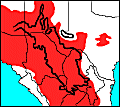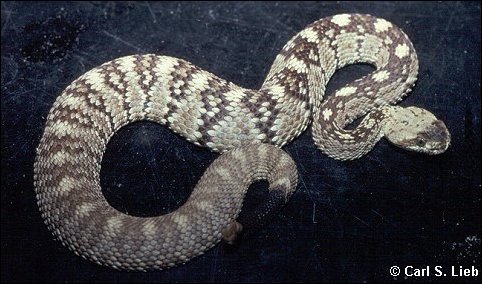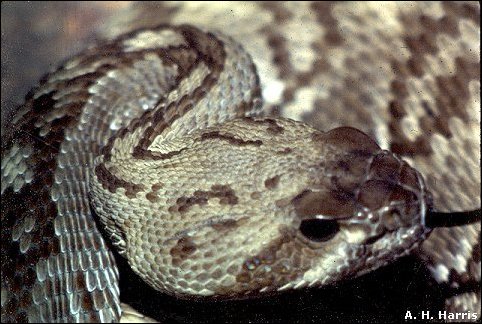


Crotalus molossus. Photographer: Dr. Carl S. Lieb. Hueco Mountains, El Paso Co., TX. 2 November 1990.

Crotalus molossus. Photograph by Arthur H. Harris.

Crotalus molossus. The typical rattlesnake head shape and infrared-sensitive pit (diagonally to the right and down from the eye) are apparent. The dark structure in front of the head is the tongue, extended to pick up chemical stimuli. Photographer: Arthur H. Harris.
Adult length is 28-49.5 in (70-126 cm). This species is easily identified by its black tail, of which extends from the rattle, ending abruptly at the body. Other characteristics include patches of light scales within dark crossbands and unicolored scales. According to Stebbins (1985:230), "Back with black or brown blotches or crossbands of irregular outline, each edged with whitish and having a single or double patch of light scales at the center. Dark markings toward front and middle of back sometimes diamond-shaped."
Northern Arizona to the southern edge of the Mexican Plateau; extending west to east from western Arizona to Edwards Plateau of central Texas. Elevation ranges from sea level to around 9600 ft. (2930 m).
Crotalus molossus is known to inhabit mountain terrain consisting of rockslides, outcrops, areas near cliffs, and stream courses or washes.
Like most large rattlesnakes, the Black-tailed Rattlesnake feeds mostly on mammals (mice, rats, squirrels, rabbits), but will also consume lizards, birds, and bird eggs.
Live bearing. Birth usually occurs from July through August with a brood size that varies from 3-6. Young measure about 9-11.75 in (23-30 cm) long and are similar to adults except for the dark crossbands visible on the tail.
According to collections done by Kinniburgh (1972) on the eastern and western slopes of the Franklin Mountains (El Paso, Texas), Crotalus molossus was collected in arroyos supporting oak, hackberry, cottonwood, and ash along channels of intermittent streams.
Kinniburgh, R. M. 1972. Distribution of Thermal Responses of the Rattlesnake (Genus Crotalus) in El Paso County, Texas. University of Texas at El Paso.
Klauber, L. M. 1982. Rattlesnakes. University of California Press, Berkeley.
Stebbins, R. C. 1985. A Field Guide to Western Reptiles and Amphibians. Houghton Mifflin Company, Boston.
Tennant, A. 1985. A Field Guide to Texas Snakes. Texas Monthly Press, Hong Kong.
William D. Beltran, July 1997.
Last Update: 11 Jul 2009